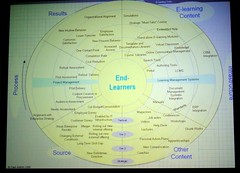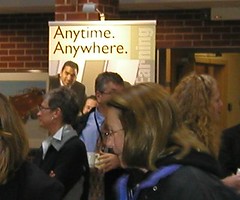Friday, May 20, 2005
Uta and I flew back to San Francisco from Fredericton yesterday. We left at 5:30 pm and arrived at SFO about midnight, after setting our watches back four hours. I use flight time for reflection. Here are some thoughts I wrote somewhere over the American heartland.

In the best-selling The World is Flat, Tom Friedman says that with the advent of interoperability, “we were not just able to talk to each other more, we were able to do more things together. This is the key point, argued Joel Cawley, the IBM strategist. ‘We were not just communicating with each other more than ever, we were now able to collaborate—to build coalitions, projects, and products together—more than ever.’”
To collaborate is to work with (co-labor), and it’s an increasingly important aspect of business. People have always worked with one another face-to-face, but these days collaboration is facilitated by technology. Telephone, VoIP, phone messaging, instant messenging, email, chat, websites, discussion boards, virtual classrooms, video conferences, and wikis connect workers, suppliers, partners, and customers.
Tapping the organization’s knowledge, getting the information to make decisions, and mastering complex subjects depend upon rapid, reliable collaboration. Facile, fast connections to others in the organization are the key to successful informal learning. Yet for all the benefits, collaboration in most organizations remains fragmented.
Instant messaging is not connected to email, nor chat to websites, nor wisdom from discussions to a knowledge repository. All of these technologies comply with accepted standards, but they don’t often work together because organizations have historically implemented them one at a time. Corporations that are integrating applications at the enterprise level are often hobbled by standalone collaborative technologies that were glued together haphazardly if at all.
Piecemeal approaches exist because organizations do not consider collaboration their core activity. In The Only Sustainable Advantage, John Hagel and John Seely Brown describe a world where firms “dynamically specialize,” and become the acknowledged innovators in their specialty. Every activity is somebody’s core, and you can bet that they’ll be good at it.
Suppose a company made collaboration its core specialization. They would research what it takes to become the undisputed best provider of collaborative technology. To become irresistible to outsourcers, they would offer:
• Integration of all collaboration technologies to make it easy to communicate with the right people in the best way.
• Synchronization of the enterprise in support of business goals, with concurrent demolition of collaborative silos.
• Capture and rating of intellectual capital derived from multiple sources into a single, searchable knowledgebase.
• Support of communities of practice, coaching and mentoring, and knowledge exchange to designated groups or individuals.
• Reputation systems to build trusting relationships and identify hidden experts.
• Reports to pinpoint traffic patterns and support of social network analysis,
• Implementation like salesforce.com: simple to put in place, no software to install, no upgrade hassles, and immediate access.
One organization has spent the better part of the last three years developing just such a collaboration platform. You probably haven’t heard of them because their bolt-on collaboration suite was designed as a private-label service. Training providers, eLearning companies, or dispersed organizations flip the switch, and their discussion boards, collaborative mentoring, communities of practice, and other media appear as home-grown applications.
The firm is named Ensemble Collaboration.
 Ensemble is based in Fredericton, New Brunswick, Canada. (With a boost from government, New Brunswick is becoming a hotbed of eLearning companies.) I spent several hours yesterday looking at the product, which goes live next week, and talking with Ensemble's founder, Ben Watson. Ben and I go back to SmartForce days when he was resident futurist and I a marketing advisor.
Ensemble is based in Fredericton, New Brunswick, Canada. (With a boost from government, New Brunswick is becoming a hotbed of eLearning companies.) I spent several hours yesterday looking at the product, which goes live next week, and talking with Ensemble's founder, Ben Watson. Ben and I go back to SmartForce days when he was resident futurist and I a marketing advisor.
DISCLOSURE: I currently serve as Ensemble Collaboration's Chairman.
 Engage Interactive, also in Fredericton, demonstrated some handsome continuing medical ed applications running on a PDA -- with stereo sound. Very cool, but I wonder if older docs are really going to be able to read from a screen the size of a pack of non-filter cigarettes.
Engage Interactive, also in Fredericton, demonstrated some handsome continuing medical ed applications running on a PDA -- with stereo sound. Very cool, but I wonder if older docs are really going to be able to read from a screen the size of a pack of non-filter cigarettes.
Click an image for larger than life-size.

The facilities at University of New Brunswick (the second oldest public institution of higher learning in North America) were great. The main hall was a amphitheater of tiered seats. Wi-Fi enabled. The only problem was a paupacity of electrical outlets for laptops.
In my research on informal learning, I'm going to have to figure out a way to do a cost/benefit analysis on decent meeting facilities. Many companies I've visited herd employees into the cafeteria for major announcements. I've yet to find a cafeteria with decent acoustics.
 Participants in the CSTD symposium ranged from people with no prior knowledge of eLearning to veterans and thought leaders. My perspective is very conceptual, so I could be wrong here, but I imagine this graphic from Clark Aldrich has something for everybody. It's a great synthesis that prompts you to be balanced in designing and implementing eLearning.
Participants in the CSTD symposium ranged from people with no prior knowledge of eLearning to veterans and thought leaders. My perspective is very conceptual, so I could be wrong here, but I imagine this graphic from Clark Aldrich has something for everybody. It's a great synthesis that prompts you to be balanced in designing and implementing eLearning.

Am I the only person who's getting tired of the Anytime/Anywhere meme?
Omnipresence is a feature of the 24/7 internet, not an individual product. Touting Anytime/Anywhere is like labeling bags of carrots "Contains No Cholesterol" or "No Animals Died in the Production of this Product."


Enterprise Collaboration Integration
People are an organization’s most valuable asset but many companies miss a great opportunity to leverage their people’s abilities. Individual performance is rewarded with bonuses, promotion, and advancement. However, individuals do not create profits; profit comes from people working together. Few organizations take advantage of readily-available technology to make it simpler, faster, and easier for their people to work with one another.In the best-selling The World is Flat, Tom Friedman says that with the advent of interoperability, “we were not just able to talk to each other more, we were able to do more things together. This is the key point, argued Joel Cawley, the IBM strategist. ‘We were not just communicating with each other more than ever, we were now able to collaborate—to build coalitions, projects, and products together—more than ever.’”
To collaborate is to work with (co-labor), and it’s an increasingly important aspect of business. People have always worked with one another face-to-face, but these days collaboration is facilitated by technology. Telephone, VoIP, phone messaging, instant messenging, email, chat, websites, discussion boards, virtual classrooms, video conferences, and wikis connect workers, suppliers, partners, and customers.
Tapping the organization’s knowledge, getting the information to make decisions, and mastering complex subjects depend upon rapid, reliable collaboration. Facile, fast connections to others in the organization are the key to successful informal learning. Yet for all the benefits, collaboration in most organizations remains fragmented.
Instant messaging is not connected to email, nor chat to websites, nor wisdom from discussions to a knowledge repository. All of these technologies comply with accepted standards, but they don’t often work together because organizations have historically implemented them one at a time. Corporations that are integrating applications at the enterprise level are often hobbled by standalone collaborative technologies that were glued together haphazardly if at all.
Piecemeal approaches exist because organizations do not consider collaboration their core activity. In The Only Sustainable Advantage, John Hagel and John Seely Brown describe a world where firms “dynamically specialize,” and become the acknowledged innovators in their specialty. Every activity is somebody’s core, and you can bet that they’ll be good at it.
Suppose a company made collaboration its core specialization. They would research what it takes to become the undisputed best provider of collaborative technology. To become irresistible to outsourcers, they would offer:
• Integration of all collaboration technologies to make it easy to communicate with the right people in the best way.
• Synchronization of the enterprise in support of business goals, with concurrent demolition of collaborative silos.
• Capture and rating of intellectual capital derived from multiple sources into a single, searchable knowledgebase.
• Support of communities of practice, coaching and mentoring, and knowledge exchange to designated groups or individuals.
• Reputation systems to build trusting relationships and identify hidden experts.
• Reports to pinpoint traffic patterns and support of social network analysis,
• Implementation like salesforce.com: simple to put in place, no software to install, no upgrade hassles, and immediate access.
One organization has spent the better part of the last three years developing just such a collaboration platform. You probably haven’t heard of them because their bolt-on collaboration suite was designed as a private-label service. Training providers, eLearning companies, or dispersed organizations flip the switch, and their discussion boards, collaborative mentoring, communities of practice, and other media appear as home-grown applications.
The firm is named Ensemble Collaboration.
 Ensemble is based in Fredericton, New Brunswick, Canada. (With a boost from government, New Brunswick is becoming a hotbed of eLearning companies.) I spent several hours yesterday looking at the product, which goes live next week, and talking with Ensemble's founder, Ben Watson. Ben and I go back to SmartForce days when he was resident futurist and I a marketing advisor.
Ensemble is based in Fredericton, New Brunswick, Canada. (With a boost from government, New Brunswick is becoming a hotbed of eLearning companies.) I spent several hours yesterday looking at the product, which goes live next week, and talking with Ensemble's founder, Ben Watson. Ben and I go back to SmartForce days when he was resident futurist and I a marketing advisor.DISCLOSURE: I currently serve as Ensemble Collaboration's Chairman.
Mobile
 Engage Interactive, also in Fredericton, demonstrated some handsome continuing medical ed applications running on a PDA -- with stereo sound. Very cool, but I wonder if older docs are really going to be able to read from a screen the size of a pack of non-filter cigarettes.
Engage Interactive, also in Fredericton, demonstrated some handsome continuing medical ed applications running on a PDA -- with stereo sound. Very cool, but I wonder if older docs are really going to be able to read from a screen the size of a pack of non-filter cigarettes.Click an image for larger than life-size.

The facilities at University of New Brunswick (the second oldest public institution of higher learning in North America) were great. The main hall was a amphitheater of tiered seats. Wi-Fi enabled. The only problem was a paupacity of electrical outlets for laptops.
In my research on informal learning, I'm going to have to figure out a way to do a cost/benefit analysis on decent meeting facilities. Many companies I've visited herd employees into the cafeteria for major announcements. I've yet to find a cafeteria with decent acoustics.
Most Useful Graphic
 Participants in the CSTD symposium ranged from people with no prior knowledge of eLearning to veterans and thought leaders. My perspective is very conceptual, so I could be wrong here, but I imagine this graphic from Clark Aldrich has something for everybody. It's a great synthesis that prompts you to be balanced in designing and implementing eLearning.
Participants in the CSTD symposium ranged from people with no prior knowledge of eLearning to veterans and thought leaders. My perspective is very conceptual, so I could be wrong here, but I imagine this graphic from Clark Aldrich has something for everybody. It's a great synthesis that prompts you to be balanced in designing and implementing eLearning.Anytime/Anywhere/Any Product

Am I the only person who's getting tired of the Anytime/Anywhere meme?
Omnipresence is a feature of the 24/7 internet, not an individual product. Touting Anytime/Anywhere is like labeling bags of carrots "Contains No Cholesterol" or "No Animals Died in the Production of this Product."











0 Comments:
Post a Comment
<< Home